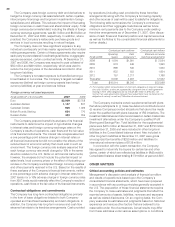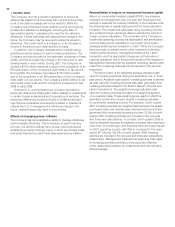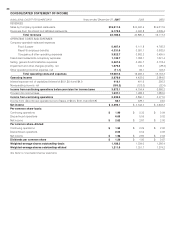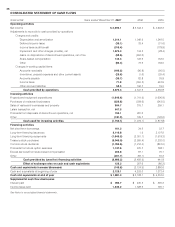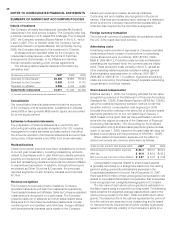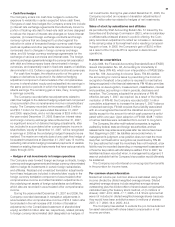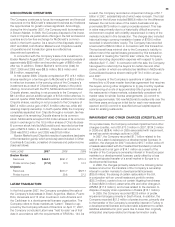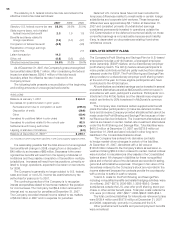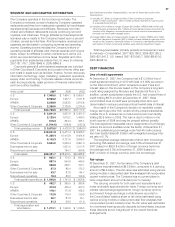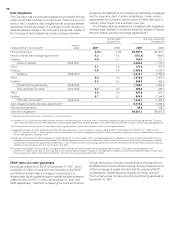McDonalds 2007 Annual Report Download - page 52
Download and view the complete annual report
Please find page 52 of the 2007 McDonalds annual report below. You can navigate through the pages in the report by either clicking on the pages listed below, or by using the keyword search tool below to find specific information within the annual report.Long-lived assets
In accordance with Statement of Financial Accounting Standards
No. 144, Accounting for the Impairment or Disposal of Long-
Lived Assets (SFAS No. 144), long-lived assets are reviewed for
impairment annually in the fourth quarter and whenever events
or changes in circumstances indicate that the carrying amount
of an asset may not be recoverable. For purposes of annually
reviewing McDonald’s restaurant assets for potential impairment,
assets are initially grouped together at a television market level
in the U.S. and at a country level for each of the international
markets. The Company manages its restaurants as a group or
portfolio with signifi cant common costs and promotional activities;
as such, an individual restaurant’s cash fl ows are not generally
independent of the cash fl ows of others in a market. If an
indicator of impairment (e.g., negative operating cash fl ows for
the most recent trailing 24-month period) exists for any group-
ing of assets, an estimate of undiscounted future cash fl ows
produced by each individual restaurant within the asset grouping
is compared to its carrying value. If an individual restaurant is
determined to be impaired, the loss is measured by the excess
of the carrying amount of the restaurant over its fair value as
determined by an estimate of discounted future cash fl ows.
Losses on assets held for disposal are recognized when
management has approved (and the Board of Directors has
approved, as required) and committed to a plan to dispose of
the assets, the assets are available for disposal, the disposal is
probable of occurring within 12 months, and the net sales pro-
ceeds are expected to be less than its net book value, among
other factors. Generally, such losses relate to restaurants that
have closed and ceased operations as well as other assets
that meet the criteria to be considered “available for sale” in
accordance with SFAS No. 144.
When the Company sells an existing business to a develop-
mental licensee, the licensee purchases the business, including
the real estate, and uses his/her capital and local knowledge to
build the McDonald’s Brand and optimize sales and profi tability
over the long term. The sale of the business includes primarily
land, buildings and improvements, and equipment, along with
the franchising and leasing rights under existing agreements.
Under the related developmental licensing arrangement, the
Company collects a royalty based on a percent of sales, as
well as initial fees, but does not have either any capital invested
in the business or any commitment to invest future capital.
An impairment charge is recognized for the difference
between the net book value of the business (including any
foreign currency translation adjustments recorded in accumu-
lated other comprehensive income in shareholders’ equity)
and the estimated cash sales price, less costs of disposal.
The Company bases its accounting policy on management’s
determination that royalties payable under its developmental
license arrangements are substantially consistent with market
rates for similar license arrangements. Therefore, the Company
believes that the recognition of an impairment charge based
on the net cash sales price refl ects the substance of the sale
transaction.
Financial instruments
The Company generally borrows on a long-term basis and is
exposed to the impact of interest rate changes and foreign
currency fl uctuations. The Company uses foreign currency
denominated debt and derivative instruments to manage the
impact of these changes. The Company does not use derivatives
with a level of complexity or with a risk higher than the exposures
to be hedged and does not hold or issue derivatives for
trading purposes.
The counterparties to these agreements consist of a diverse
group of fi nancial institutions. The Company continually monitors
its positions and the credit ratings of its counterparties and
adjusts positions as appropriate. The Company did not have
signifi cant exposure to any individual counterparty at
December 31, 2007 and has master agreements that contain
netting arrangements. Some of these agreements also require
each party to post collateral if credit ratings fall below, or
aggregate exposures exceed, certain contractual limits. At
December 31, 2007 and 2006, the Company was required to
post collateral of $54.8 million and $49.3 million, respectively,
which was used to reduce the carrying value of the derivatives
recorded in other long-term liabilities.
Statement of Financial Accounting Standards No. 133,
Accounting for Derivative Instruments and Hedging Activities
(SFAS No. 133), as amended, requires companies to recognize
all derivatives as either assets or liabilities in the balance sheet
at fair value. SFAS No. 133 also requires companies to designate
all derivatives that qualify as hedging instruments as fair value
hedges, cash fl ow hedges or hedges of net investments in
foreign operations. This designation is based upon the exposure
being hedged.
The Company’s derivatives primarily consist of interest
rate exchange agreements, foreign currency exchange
agreements and foreign currency options. These derivatives
were classifi ed in the Consolidated balance sheet at
December 31, 2007 and 2006, respectively, as follows:
miscellaneous other assets–$63.7 million and $40.6 million;
and other long-term liabilities (excluding accrued interest)–
$70.3 million and $116.5 million. All derivative purchases and
settlements were classifi ed in other fi nancing activities in the
Consolidated statement of cash fl ows.
There was no signifi cant impact to the Company’s earnings
related to the ineffective portion of any hedging instruments for
the three years ended December 31, 2007.
• Fair value hedges
The Company enters into fair value hedges to reduce the exposure
to changes in the fair values of certain assets or liabilities. The
types of fair value hedges the Company enters into include
(i) interest rate exchange agreements to convert a portion of
its fi xed-rate debt to fl oating-rate debt and (ii) foreign currency
exchange agreements for the exchange of various currencies
and interest rates. The foreign currency exchange agreements
are entered into to hedge the currency risk associated with
debt denominated in foreign currencies, and essentially result in
fl oating-rate liabilities denominated in U.S. Dollars or appropriate
functional currencies.
For fair value hedges, the gains or losses on derivatives as
well as the offsetting gains or losses on the related hedged
items resulting from changes in fair value are recognized in
nonoperating income, net.
50


